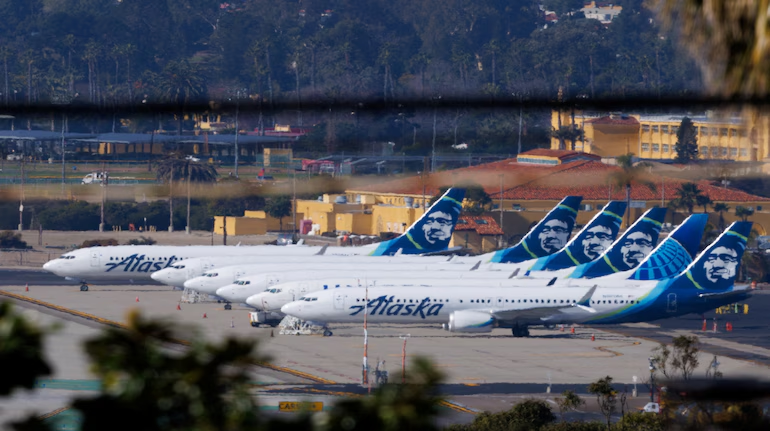Alaska Airlines experienced a significant operational disruption on Sunday evening, July 20, 2025, when an IT outage forced the carrier to implement a temporary system-wide ground stop affecting all mainline and Horizon Air flights across the United States.
The three-hour ground stop, which began at approximately 8 p.m. Pacific Time (11 p.m. Eastern Time), impacted hundreds of flights and thousands of passengers, marking one of the most significant operational challenges for the Seattle-based airline in recent months.
Timeline of Events
The IT outage and subsequent ground stop unfolded rapidly on Sunday evening:
- 8:00 PM PT: Alaska Airlines first experienced the IT system failure affecting operations
- 8:30 PM PT: The airline formally requested a ground stop from the Federal Aviation Administration
- 10:52 PM ET: FAA officially implemented the nationwide ground stop for all Alaska Airlines mainline flights
- 11:00 PM PT: Ground stop was lifted after three hours
- 2:00 AM ET Monday: Operations resumed with ongoing residual delays
Impact on Operations
The ground stop affected both Alaska Airlines mainline operations and its regional subsidiary, Horizon Air. However, SkyWest flights operating under the Alaska Airlines brand were excluded from the advisory.
According to airline officials, more than 200 aircraft were impacted by the ground stop, causing widespread disruptions at major hubs including Seattle-Tacoma International Airport, Portland International Airport, and Anchorage Ted Stevens International Airport.
Key Operational Impacts:
- All departing flights were held at their origin airports
- Airborne flights were allowed to continue to their destinations
- Crew scheduling systems were temporarily unavailable
- Weight and balance calculations were affected
- Check-in and boarding processes experienced delays
What Caused the IT Outage?
Alaska Airlines has not disclosed the specific technical details behind the IT failure. The airline’s statement indicated that the outage affected multiple critical systems necessary for flight operations.
Industry experts suggest that such outages can stem from various issues including server failures, network connectivity problems, software glitches, or cybersecurity incidents. However, Alaska Airlines has not confirmed any specific cause.
Passenger Impact and Airline Response
The ground stop created significant challenges for travelers, with many passengers stranded at airports or experiencing lengthy delays. Alaska Airlines issued multiple statements throughout the evening to keep passengers informed.
Airline Recommendations for Affected Passengers:
- Check flight status before heading to the airport
- Use the Alaska Airlines mobile app for real-time updates
- Monitor the airline’s website at AlaskaAir.com
- Allow extra time for travel due to residual delays
- Contact customer service for rebooking options if needed
The airline emphasized that while the ground stop was lifted at 11 p.m. Pacific Time, passengers should expect continued delays as the airline works to reposition aircraft and crews across its network.
Federal Aviation Administration’s Role
The FAA played a crucial role in managing the ground stop, working closely with Alaska Airlines to ensure safety while minimizing disruptions to the national airspace system.
A ground stop is an air traffic control measure that restricts certain aircraft from taking off and requires them to remain on the ground. This tool is typically used to manage air traffic flow during emergencies, severe weather, or technical failures.

Recovery and Ongoing Operations
As operations resumed late Sunday night, Alaska Airlines warned that the recovery process would take time. The airline faced several challenges in returning to normal operations:
Recovery Challenges:
- Aircraft Positioning: Planes were out of position across the network
- Crew Scheduling: Flight crews exceeded duty time limits due to delays
- Passenger Rebooking: Thousands of passengers needed accommodation on later flights
- Baggage Handling: Luggage systems faced backlogs from the disruption
The airline indicated that residual impacts would likely continue through Monday and potentially into Tuesday as the system fully recovers.
Industry Context and Similar Incidents
This incident adds to a series of IT-related disruptions that have affected major U.S. airlines in recent years. Similar ground stops have occurred at other carriers due to technology failures, highlighting the aviation industry’s heavy reliance on complex IT systems.
In April 2024, Alaska Airlines experienced a smaller-scale ground stop related to its weight and balance system, which lasted approximately one hour. That incident affected morning operations but had less widespread impact than Sunday’s outage.
Looking Forward: Lessons and Improvements
While Alaska Airlines has not announced specific measures to prevent future IT outages, industry analysts expect the carrier to conduct a thorough review of the incident. Common post-incident actions typically include:
- Comprehensive system audits and vulnerability assessments
- Enhanced redundancy and backup systems
- Improved crisis communication protocols
- Staff training on emergency procedures
- Investment in modernized IT infrastructure
Passenger Rights and Compensation
Passengers affected by the ground stop may be entitled to certain accommodations depending on the length of their delay and specific circumstances. Alaska Airlines typically offers:
- Rebooking on the next available flight without change fees
- Meal vouchers for extended delays
- Hotel accommodations for overnight delays (in certain circumstances)
- Refunds for significantly delayed or cancelled flights
Travelers are encouraged to retain all receipts and documentation related to expenses incurred due to the disruption.
Conclusion
The Alaska Airlines ground stop on July 20, 2025, serves as a reminder of the critical role technology plays in modern aviation operations. While the three-hour disruption was resolved relatively quickly, its impact rippled through the airline’s network, affecting thousands of passengers.
As Alaska Airlines works to fully restore normal operations and address the root cause of the IT failure, the incident underscores the need for robust technology infrastructure and contingency planning in the aviation industry.
Passengers planning to travel with Alaska Airlines in the coming days should remain vigilant about checking their flight status and allowing extra time for potential residual delays as the airline continues its recovery efforts.














